Named World War I Advance Sector, Service of Supply Service Coat WWI Uniform WW1
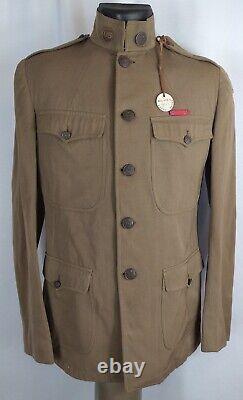
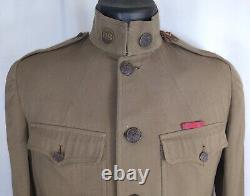
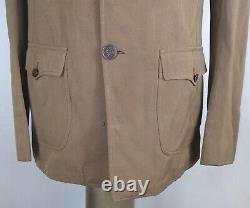
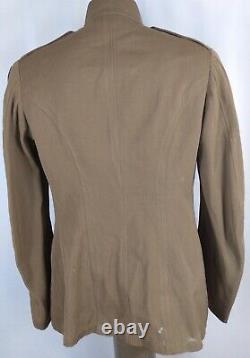

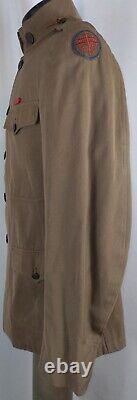

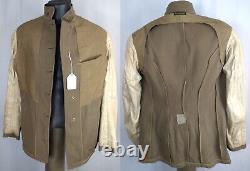
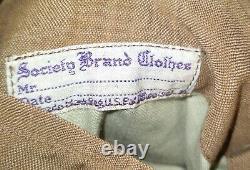
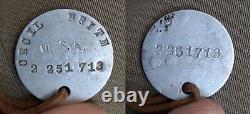
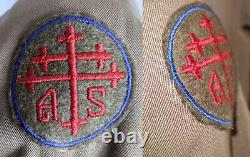
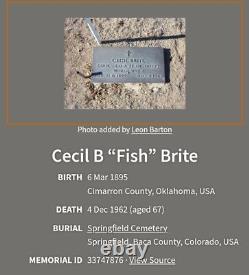

The uniform itself was tailored by "Society Brand Clothes", whose tailor label is found inside the breast pocket. It is void of any other information, including a name or size. The collars are adorned with correct US and Quartermaster Corps collar disks. The left sleeve bears the shoulder sleeve insignia of "Advanced Sector Service of Supply", which is hand-sewn to the uniform. There is a very worn pin-back ribbon bar that resembles the Nicaraguan Campaign Medal, but the vertical bars are too narrow.
I feel that this is likely from a county service medal ribbon bar, which he received as a token of gratitude by his hometown. The uniform is accompanied by his dog tag, which reads: "Cecil Brite/USA/2251713", along with only his Army Serial Number on the verso: "2251713".
This is secured by a section of rawhide lace. The uniform remains in good condition, showing signs of age, use, and wear. There is an area of notable moth damage along the entire skirt, especially to the rear. Moderate moth damage over all.
Nonetheless, this uniform displays nicely. Please see the pictures for more detail. Guaranteed 100% authentic in every respect for life. Be sure to see our other listing for more historical antiques and militaria. Be sure sure follow our store as new inventory is added daily.
Cecil Bright was born on March 6, 1895 in Cimarron County, Oklahoma. He died at age 67 on December 4, 1962 in Springfield, Bacca County, Colorado. According to his headstone, he went by the nickname "Fish". The 22nd Engineer Regiment was a Light Gauge Railway Construction unit organized at Camp Sheridan, Alabama in March 1918.
It moved to its the Port of Embarkation, Hoboken, New Jersey in June 1918, serving overseas as Army troops from June 1918 to June 1919, moving to Camp Jackson, South Carolina in June 1919, and demobilized at Camp Zachary Taylor, Kentucky in July 1919. The'Advance Sector, Service of Supply' and was worn primarily by members of the Quartermaster Corps. AEF supplies destined for the Doughboys at the front were funneled through a series of depots and installations located at key points along the'Lines of Communication' (LOC). The LOC was divided into the'Base Sector', the'Intermediate Sector' and the'Advance Sector'. The journey began at the large base depots established in the French port cities of St.
Nazarie, Le Harve, Brest, La Pallice and later Marsaeilles. Troops posted to the Base Sectors would have worn the Service of Supply or SOS shoulder sleeve insignia (SSI).
The supplies were then moved in wholesale lots from the massive base depots, up to an Intermediate Depot which was located closer to the front. The Intermediate Depot was the replenishing point for the Advanced Depots further up the line. Working at the Intermediate Sectors world have worn the Intermediate Sector, Service of Supply SSI. These Advance Depots which were also known as'Regulating Stations' were always located near a main rail line.The forward depots were better equipped for the rapid movement of large amounts of equipment and supplies that were requisitioned by daily telegrams from the line units at the front. Nothing passed through the Regulating Stations without first being ordered. This included every soldier going to or returning from leave areas, schools and hospitals.
The Advance Depots organized returning men and replacement animals by division, and resorted and repacked the requested supplies onto rail cars for daily transportation to each division's railhead. The soldiers stationed at the Advance Sectors would have worn the Advance Sector, Service of Supply SSI. In many instances, Advance Sector personnel also transported Army, Corps and Division supplies further forward, up to their respective supply dumps. Army Supply Dumps were usually located 10 to 12 miles behind the lines; Corps Supply Dumps were situated some 10 to 6 miles to the rear of the fighting; while the Division Supply Dumps were the closest, at just 4 or 5 miles behind the front lines. The supplies were again broken down and resorted based on the needs of each organization within the division. Usually everything would be loaded onto motor trucks which carried the men and equipment as far as the shell ravaged roads permitted. When the trucks could go no further, the supplies were transferred to mule and horse drawn wagons and carts to continue the journey under cover of darkness. Pack mules and carrying parties often finished the task of getting the supplies up to the firing line.The "Advance", "Intermediate" and "Base" Sectors were all separate commands within the AEF. Each of which encompassed a specific area of geography that was located behind the "Zone of Advance". The borders of those three sectors were in a constant state of flux depending on the ebb and flow of combat at the front. The personnel permanently posted to those sectors were generally support troops composed of Engineer, Quartermaster, Medical, Signal Corps, Military Police, Motor Transport, Ordnance and other personnel.
Collectively, these troops composed the personnel of each respective sector and wore the appropriate shoulder patch. However, a number of units (both large & small) within the various sectors adopted an unofficial shoulder insignia that was unique to their particular organization, and wore that instead of the shoulder insignia that had been prescribed by the AEF. In other words, the Advance Sector shoulder patch was not worn by a single branch of military service or by a single military outfit. It was worn by a wide variety AEF organizations, each of which specialized in supporting the front line combat units. Therefore the men from a butcher's outfit at a cold storage plant - laborers from a stevedore regiment - engineers operating a sawmill - mechanics at a motor park - doctors and nurses at a base hospital - supply clerks at a warehouse, and so on, were all authorized to wear the Advance Sector shoulder patch if they were based within the boundaries of that particular command.This item is in the category "Collectibles\Militaria\WW I (1914-18)\Original Period Items\United States\Uniforms". The seller is "historical_antiques" and is located in this country: US. This item can be shipped to United States.
- Conflict: WW I (1914-18)
- Original/Reproduction: Original
- Theme: Militaria
- Country/Region of Manufacture: United States
- Region of Origin: United States
- Modified Item: No

